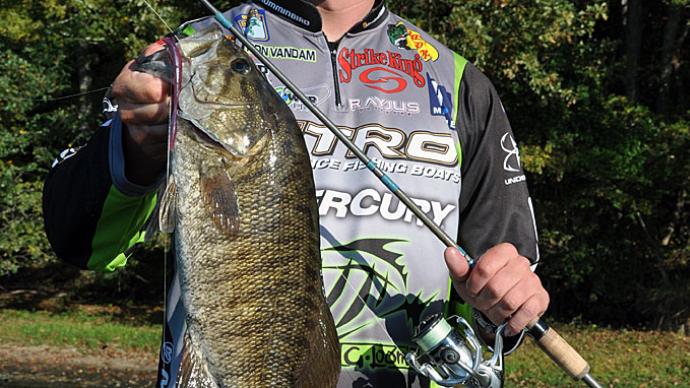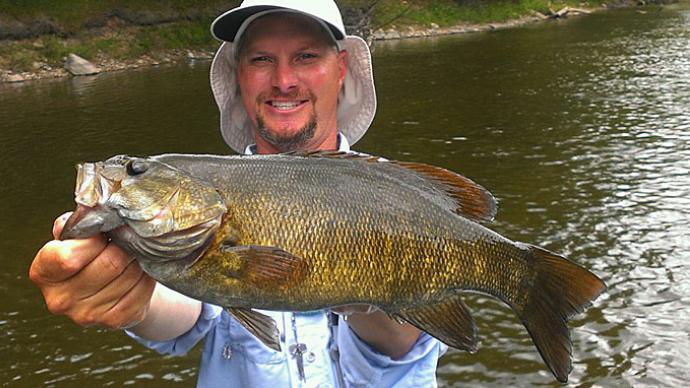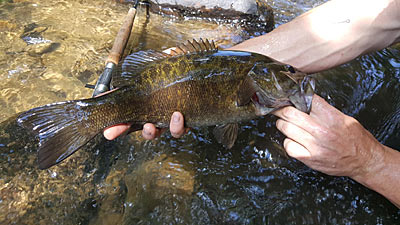
There are plenty of shallow rivers and creeks filled with smallmouth nationwide, so chances are good that you live near one of these primarily untapped fisheries. The best way to fish them is by wading, and that’s what Will Fortenbaugh has been doing for the past dozen or so years in the Nolichucky, French Broad, and other rivers around his western North Carolina home. And he has caught plenty of smallmouth to prove its effectiveness.
While wading is an option in lakes, where sand, gravel, or rock bottom offers solid footing, it’s most effective in these smaller current-driven systems. It creates access, getting off the bank or into shallow or rock-strewn water that watercraft can’t navigate. And best of all, it’s easier than you may think.
Why you should wade
Fortenbaugh said you don’t have to be an expert to wade. You only need to be OK with getting wet and enjoy catching smallmouth.
Fortenbaugh said the key is fishing stretches where you’re comfortable with the depth and current. “Some spots are easy to wade, and others are harder,” he said. “Some places, you have to swim from rock to rock.”
Runoff and rainfall change rivers daily. Fortenbaugh said different stretches of a river are accessible at different water levels. Check the water gauges along the river you want to fish. Readings from many, including those monitored by U.S. Geological Survey, are posted online. When they read low water, he said you’ll be able to fish plenty of pocket water — small spots that offer smallmouth respite from current behind a rock, log, or other obstruction. You’re usually better off at home when they read the opposite. He’s never found good fishing in a high and muddy river.
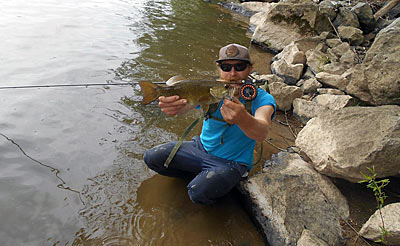
While access is what’s best about wading, the approach it provides is a close second. Fortenbaugh prefers to move upstream, taking his time and fishing thoroughly. He can cast upstream and let his lure wash downstream past a prime spot as often as he wants. “Sometimes you get in a place where you have 15 targets to fish without moving your feet,” he said. And he never worries about boat control.
Fortenbaugh is still surprised each time he exits the river and realizes how short of a stretch he has covered because of the number of spots to fish. There are always plenty of smallmouth tucked in there, too. He said he and a couple of buddies could catch and release about 100 smallmouth on a good day. Many will weigh between 2 and 3 pounds, and the largest will push 5 pounds. “Those are special,” he said.
Fortenbaugh has caught river smallmouth on many different lures, from soft-plastic grubs to topwaters, his favorite. Now he uses a fly rod to cast streamers, such as Clouser minnows and poppers. And like smallmouth everywhere, river ones jump, run, and pull strong. “They’ll try to eat [your lure] out of another one’s mouth,” he said. “They are nuts.”
A little gear is all you need
Wading for smallmouth doesn’t require specialized gear, although it exists if you prefer. Fortenbaugh prefers “wet wading.” He shuns traditional chest waders and dons a long-sleeve sun shirt, shorts, and an old pair of slip-on skateboarding sneakers. He feels their flat rubber soles offer plenty of traction on slippery river bottoms, and after he cuts holes in their sides to release any small rocks that might get stuck inside, they’re comfortable. He also uses a backpack, stashes his tackle, and a dry bag that protects his camera and lunch.
Fortenbaugh will wet wade in the water as cool as 60 degrees as long as the upper half of his body stays dry. Even with that consideration, he wades his hometown rivers from May through September, when the smallmouth are most active.
Fortenbaugh isn’t the only one that recommends wet wading. “If you can get away without waders, you’re better off,” said Tom Rosenbauer, rod and tackle marketing director for Vermont-based The Orvis Co., well-known for fly-fishing gear. He also suggests shorts and offers quick-dry pants as an option. But wading boots are a necessity for him.
Rosenbauer said boots offer more support than sneakers for ankles, which can take a beating on uneven river bottoms. Each pair comes with two types of soles — rubber or felt. Both have benefits. Felt soles are best on slippery rocks. But they make for challenging hiking to and from the river.
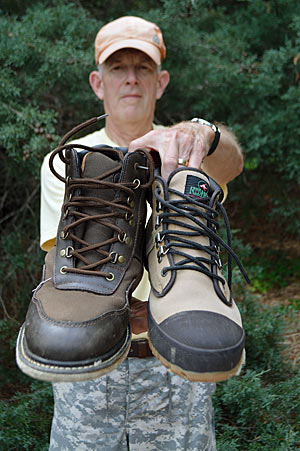
Rubber-soled wading boots have a good grip in and out of the water. Rosenbauer said their traction improves with the addition of studs. Orvis, for example, offers low-profile tungsten-carbide ones that screw into the sole with a socket wrench or electric drill. “That really gives you a lot of security and safety,” he said.
Asheville, N.C., resident Don Funderud knows western North Carolina’s rivers and streams well after fishing them for about 50 years. But even with that familiarity, he still uses his feet to feel for the rocks he can’t see, saving him from an unintended swim. He finds more while wearing light-weight boots. And he’s very particular about their soles. “I don’t wade unless I have felt-bottom boots,” he said.
If you wish your rubber-soled boots were felt-covered, Funderud has a DIY solution for you. Cut a piece of indoor-outdoor carpet — it must-have fabric backing — in the general shape of each boot’s sole. Next, swab the backside of each piece and sole with contact cement, letting them dry until tacky. Press them together, using a bottle to roll a tight bond. After they dry completely, trim the edges and seal them with a marine-grade adhesive. They’ll be ready to fish after drying overnight.
But before you make your final decision on soles, check your local fishing regulations. Felt soles are banned in some waters because they transmit pathogens, including the single-cell algae didymo — “rock snot” — forming a thick brown mat on river bottoms. It’s similar to boats and trailers spreading invasive species, such as zebra mussels, between bodies of water. But even rubber-bottomed boots, and waders for that matter, aren’t always sterile. They should be dried thoroughly or washed with a solution of bleach or detergent between fishing trips.
Whichever sole you choose, resist the temptation to go barefoot inside the boot. “You’re going to be sorry,” Rosenbauer said. It’s a quick way to create painful blisters on your feet. He said he protected them by wearing an old pair of gym socks or neoprene booties.
Fortenbaugh wears wool socks. “They work like a wet suit,” he said. The socks retain water, which is warmed by your body heat, keeping you warm.
Whether you choose socks or booties, bring them when you buy your wading boots. Rosenbauer said that will ensure a proper fit because some brands run a size larger than your street shoes and others smaller. “They should feel a little bit snug with a sock,” he said. That way, you’ll be good to go after they stretch slightly when wet.
If you want waders, here’s what to get
Rosenbauer said there are times when wet wading isn’t the best option, such as an evening trip or early or late in the season. If that’s when you are fishing, he suggests stocking foot waders made from a lightweight, breathable material. Not only will they be more comfortable in warmer temperatures, but they’re also easy to walk in. You’ll still need boots, which also give you the option of wet wading.
Like boots, you need to try waders on when it’s time to buy. It’s the best way to find the correct size. They’ll come with a belt, which you’ll need to keep tight while wading. If you don’t and take a spill, the waders will fill with water and pull you downstream, possibly under, like a sea anchor. He said that a tight belt also might be enough to keep the cellphone inside your pocket safe.
And no matter how tempting they may seem, Rosenbauer said to pass on hip waders, which are essentially leg-length boots that strap to your belt. Even if you’re extra careful, he said it’s only a matter of time before you take one step too deep and fill them with water.



